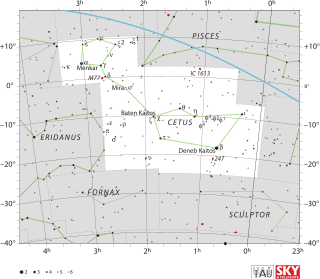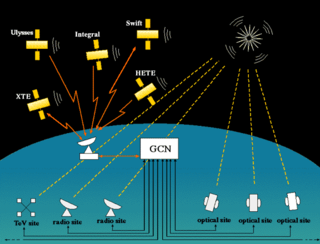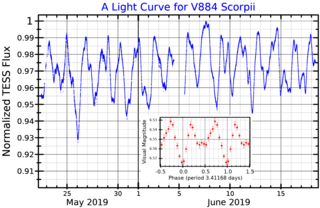
Compton scattering is the quantum theory of high frequency photons scattering following an interaction with a charged particle, usually an electron. Specifically, when the photon hits electrons, it releases loosely bound electrons from the outer valence shells of atoms or molecules.

The Compton Gamma Ray Observatory (CGRO) was a space observatory detecting photons with energies from 20 keV to 30 GeV, in Earth orbit from 1991 to 2000. The observatory featured four main telescopes in one spacecraft, covering X-rays and gamma rays, including various specialized sub-instruments and detectors. Following 14 years of effort, the observatory was launched from Space Shuttle Atlantis during STS-37 on April 5, 1991, and operated until its deorbit on June 4, 2000. It was deployed in low Earth orbit at 450 km (280 mi) to avoid the Van Allen radiation belt. It was the heaviest astrophysical payload ever flown at that time at 16,300 kilograms (35,900 lb).
The Max Planck Institute for Extraterrestrial Physics is part of the Max Planck Society, located in Garching, near Munich, Germany. In 1991 the Max Planck Institute for Physics and Astrophysics split up into the Max Planck Institute for Extraterrestrial Physics, the Max Planck Institute for Physics and the Max Planck Institute for Astrophysics. The Max Planck Institute for Extraterrestrial Physics was founded as sub-institute in 1963. The scientific activities of the institute are mostly devoted to astrophysics with telescopes orbiting in space. A large amount of the resources are spent for studying black holes in the Milky Way Galaxy and in the remote universe.

Gamma-ray spectroscopy is the qualitative study of the energy spectra of gamma-ray sources, such as in the nuclear industry, geochemical investigation, and astrophysics. Gamma-ray spectrometry, on the other hand, is the method used to acquire a quantitative spectrum measurement.

Gamma Ceti is a triple star system in the equatorial constellation of Cetus. It has a combined apparent visual magnitude of 3.47. Based upon parallax measurements, this star is located at a distance of about 80 light-years from the Sun.

The General Coordinates Network (GCN), formerly known as the Gamma-ray burst Coordinates Network, is an open-source platform created by NASA to receive and transmit alerts about astronomical transient phenomena. This includes neutrino detections by observatories such as IceCube or Super-Kamiokande, gravitational wave events from the LIGO, Virgo and KAGRA interferometers, and gamma-ray bursts observed by Fermi, Swift or INTEGRAL. One of the main goals is to allow for follow-up observations of an event by other observatories, in hope to observe multi-messenger events.
LS I +61 303 is a microquasar, a binary system containing a massive star and a compact object. The compact object is a pulsar and the system is around 7,000 light-years away.

A telescope is a device used to observe distant objects by their emission, absorption, or reflection of electromagnetic radiation. Originally it was an optical instrument using lenses, curved mirrors, or a combination of both to observe distant objects – an optical telescope. Nowadays, the word "telescope" is defined as a wide range of instruments capable of detecting different regions of the electromagnetic spectrum, and in some cases other types of detectors.

RX J0852.0−4622 is a supernova remnant. The remnant is located in the southern sky in the constellation Vela ("sail"), and sits inside the much larger and older Vela Supernova Remnant. For this reason, RX J0852.0−4622 is often referred to as Vela Junior. There have been a minority of suggestions that the remnant may be a spurious identification of a complicated substructure within the larger and better studied Vela SNR, but most studies accept that G266.2−1.2 is a SNR in its own right. Indeed, its detection in the high energy Teraelectronvolt range by the High Energy Stereoscopic System in 2005 is strong confirmation of such.

4U 1700-37 is one of the stronger binary X-ray sources in the sky, and is classified as a high-mass X-ray binary. It was discovered by the Uhuru satellite. The "4U" designation refers to the fourth Uhuru catalog.

A gamma ray, also known as gamma radiation (symbol
γ
), is a penetrating form of electromagnetic radiation arising from the radioactive decay of atomic nuclei. It consists of the shortest wavelength electromagnetic waves, typically shorter than those of X-rays. With frequencies above 30 exahertz (3×1019 Hz), each gamma ray imparts the highest photon energy of any form of electromagnetic radiation. Paul Villard, a French chemist and physicist, discovered gamma radiation in 1900 while studying radiation emitted by radium. In 1903, Ernest Rutherford named this radiation gamma rays based on their relatively strong penetration of matter; in 1900 he had already named two less penetrating types of decay radiation (discovered by Henri Becquerel) alpha rays and beta rays in ascending order of penetrating power.

Gamma-ray astronomy is the astronomical observation of gamma rays, the most energetic form of electromagnetic radiation, with photon energies above 100 keV. Radiation below 100 keV is classified as X-rays and is the subject of X-ray astronomy.
The Whole Earth Blazar Telescope (WEBT) is an international consortium of astronomers created in 1997, with the aim to study a particular category of Active Galactic Nuclei (AGN) called blazars, which are characterized by strong and fast brightness variability, on time scales down to hours or less.

Terzan 5 is a heavily obscured globular cluster belonging to the bulge of the Milky Way galaxy. It was one of six globulars discovered by French astronomer Agop Terzan in 1968 and was initially labeled Terzan 11. The cluster was cataloged by the Two-Micron Sky Survey as IRC–20385. It is situated in the Sagittarius constellation in the direction of the Milky Way's center. Terzan 5 probably follows an unknown complicated orbit around the center of the galaxy, but currently it is moving towards the Sun with a speed of around 90 km/s.

Gamma Crateris is a binary star system, divisible with a small amateur telescope, and located at the center of the southern constellation of Crater. It is visible to the naked eye with an apparent visual magnitude of 4.06. With an annual parallax shift of 39.62 mas as seen from Earth, this star is located 82.3 light years from the Sun. Based upon the motion of this system through space, it is a potential member of the Castor Moving Group.

Elena Aprile is an Italian-American experimental particle physicist. She has been a professor of physics at Columbia University since 1986. She is the founder and spokesperson of the XENON Dark Matter Experiment. Aprile is well known for her work with noble liquid detectors and for her contributions to particle astrophysics in the search for dark matter.
Centrifugal acceleration of astroparticles to relativistic energies might take place in rotating astrophysical objects. It is strongly believed that active galactic nuclei and pulsars have rotating magnetospheres, therefore, they potentially can drive charged particles to high and ultra-high energies. It is a proposed explanation for ultra-high-energy cosmic rays (UHECRs) and extreme-energy cosmic rays (EECRs) exceeding the Greisen–Zatsepin–Kuzmin limit.

DS Tucanae is a binary star system 144 light years away in the constellation of Tucana. It has an apparent visual magnitude of 8.5, and is a RS Canum Venaticorum variable. The system is notable for being young as a member of the 45 Myr old Tucana-Horologium moving group and for the primary star hosting the confirmed exoplanet DS Tucanae Ab, discovered by THYME, using TESS.

Anna Barnacka is a Polish astrophysicist and entrepreneur. She is known for her work on gravitational lensing, and astroparticle physics.

3C 345 is a blazar/flat spectrum radio quasar located in the constellation of Hercules. It is noted for hosting a superluminal jet and its variability in almost all wave bands.
















